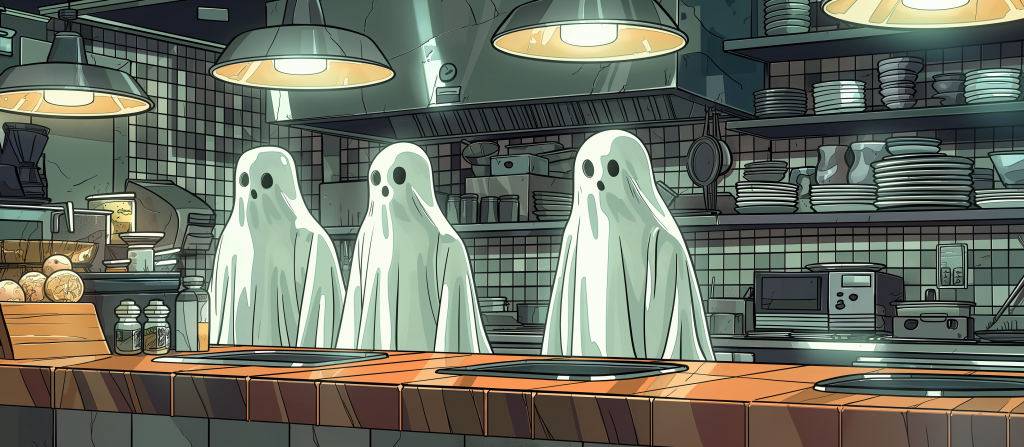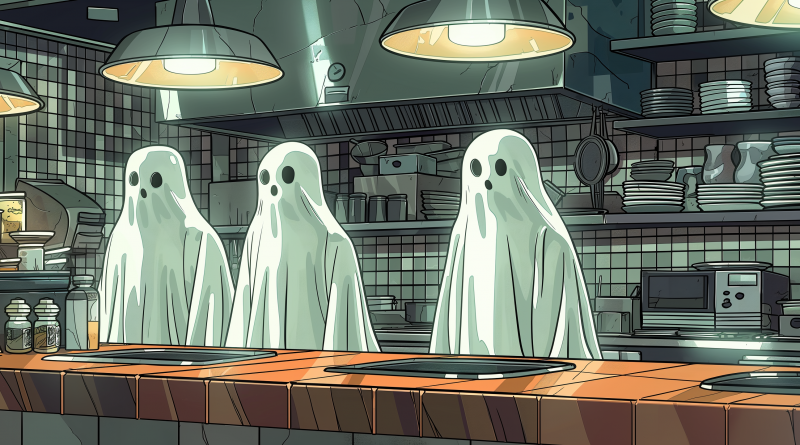Burgerbanism: Ghost Kitchens, The Latest Wild Idea In Restaurant Innovation
At least a few times a year, I am confronted with some sort of example of innovation that might well either be nightmarish or ingenious. The latest– and I should say that I haven’t figured out exactly where it fits here- is the concept of a ghost kitchen, which I just learned about yesterday. Ghost kitchens, also called “delivery-only kitchens,” are basically virtual restaurant brands. The product is a branded takeout food product that is produced in an existing commercial kitchen, but sold exclusively online through a service like DoorDash or Uber Eats, usually appearing as its own independent thing. The difference is that you can’t physically go and buy it. The branding usually has nothing to do with the business that produces it, and major national brands have bought into this trend.

Why Now?
Remember the pandemic?! A lot of restaurants had to get creative to survive when they weren’t hosting dine-in traffic. In Detroit, for example, we regularly picked up takeout from places like YumVillage, or availed ourselves of the pandemic-revised, more takeout-friendly menu of otherwise exorbitant sit-down fine dining spots like Takoi. We’ve since enjoyed getting takeout from a limited number of spots in cases where they might lack a particularly appealing dine-in experience, like the frigid cool white glow of dining at Charminar, which has great takeout options.
Indeed, takeout and delivery specifically are really popular in pretty much every market. Since the pandemic, the restaurant industry estimates that 60% of Americans order takeout or delivery an average of once a week. I think this can probably be attributed substantially to the fact that the United States has become mostly a low-density suburban country, and this means that people are willing to pay a huge premium on food prices to have stuff delivered to them rather than have to brave traffic only to travel to some illustrious strip mall to wait for their treats.
Restaurants have decided that perhaps the best way to exploit this trend is to create limited, small menus of a specific type of food– one mentioned from Bloomin Brands is one of these virtual restaurants that specializes in chicken fingers. We do live in the post-burger age, of course, and the popularity of fried chicken must be some sort of economic bubble. But I’ve been utterly underwhelmed by most of the products I’ve seen offered from examples of this brandception– a brand within a brand, that is.
The benefit to the restaurants is that they’re able to explore new market opportunities without having to assume the massive liability of developing a new facility. Theoretically, it could create more steady cash flow, and it could theoretically do this without putting much additional strain on an already constrained labor force. It’s doubtful that DoorDash or similar vendors will be tipping-out the back-of-house staff, but it’s certainly worth considering for how a ghost kitchen could normalize product demand over longer periods, either within a shift or over many months.
The Urbanism Side of Ghost Food
In terms of the built environment, it may be valuable for us to understand chain restaurants as being located in some sort of market distortion quantum singularity. The strategy of building chain restaurants usually involves plopping them down in some brand new strip mall. The strip mall, in turn, has been subsidized substantially through public expenditure on things like new roads, new sewer, water, and power infrastructure, or what have you. Thus, the development of a chain restaurant usually has little to nothing to do with any sort of urban context, and everything to do with a macro look at the market (I’ve seen the reports that are used to justify this sort of thing and they refer to things like “number of parking spaces” and “number of people of our target market demographic within a 2.6 mile drive” or what have you.
It’s quite silly. But it also might give us a glimpse into a deeper complexity of the suburban restaurant chain industrial complex, and that’s that if these companies are really looking to eke out a few additional percentage points of revenue, it’s perhaps indicative of a bigger problem. I have a hard time finding restaurants where I live that don’t have irritatingly long waits on a weekend night, for example. Can we say the same for, I don’t know, a Red Lobster or an Applebee’s in an exurb? Americans are spending more than we ever have at restaurants, according to recent data. But as the business cycle reaches its natural and inevitable end, companies will always try and squeeze out a couple more dollars.
Of course, the economy is always going to be like this, but the economy doesn’t need to always involve us buying food in shitty strip malls. Even if our local restaurants don’t involve having 76 off-street parking spaces in a shopping center built using TIF. Let’s dream bigger, people.
Conclusions
Ultimately, it seems like the average ghost kitchen is sort of just the gastro-business equivalent of throwing something at the wall and seeing what sticks.
“Is it good food?” I asked a colleague who told me about the phenomenon.
“No,” he confessed, “but, like, it’s not any worse than anyone else’s chicken fingers.”
Convenience, of course– of not having to leave your house and allowing a poorly-paid 1099 worker to deliver the goods- is worth a premium to the average consumer. It seems to be working, with Statista claiming that the delivery and takeout market is set to eclipse $1 trillion in revenue. As someone who orders delivery maybe all of twice a year and carryout maybe 2-4 times a year, I have a really hard time believing that number, but I also had a hard time believing that people would pay $20 to get a cold McDonald’s sandwich delivered to their door because they can’t be bothered to go pick it up themselves.
Check out some comprehensive stats from DoorDash on the subject.



